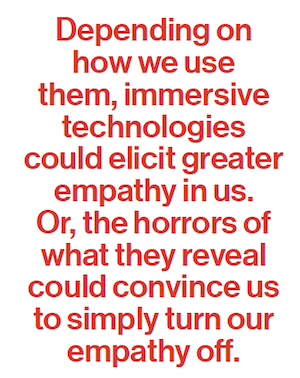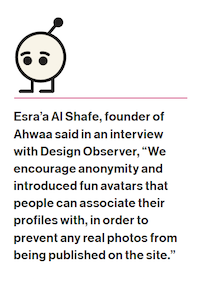Future Now
The IFTF Blog
Take to the Cyber Streets!
Fighting the war on organizing with immersive remote participation
In 2015, Spain’s government passed the so-called “ley mordaza,” a “gag law” designed to make it illegal to protest or film outside of government buildings. This includes taking photos or video of security officers, if doing so “might endanger their security.” One of the first fines under this law reflected its scope for abuse. It was issued against a woman who took a photo of a police car in a disabled parking bay and posted it on Facebook. In response to the law, the #NoSomosDelito (We Are Not a Crime) and “Holograms for Freedom” campaigns instigated a protest outside the Spanish Parliament. The ghostly light-avatars of protesters were projected as holograms into the contested physical space. The message was clear: if you take away people’s right to physically assemble, they will employ available digital technologies to make their presence felt regardless.
 The current landscape of human rights activism enabled by technology and social media is diverse and growing. In communities from Cleveland to Rio de Janeiro, for instance, marginalized African-American and Afro-Brazilian citizens grapple with the terrors of systemic police misconduct. In response, movements like #BlackLivesMatter in the U.S. and #NosPorNos in Brazil have taken the pervasive power of eyewitness police-violence videos and hashtag activism, and aligned it with calls for policy changes on systemic discrimination. In countries where same-sex love is culturally scorned and against the law, LGBTQ people connect with each other pseudonymously on sites like Facebook as they search out private spaces in which to connect. Real-time war crimes in Syria, Iraq, and elsewhere are captured at tremendous scale both by perpetrators looking to terrorize the global mediasphere and recruit new followers, and by citizens using increasingly available witnessing tools to hold the perpetrators accountable.
The current landscape of human rights activism enabled by technology and social media is diverse and growing. In communities from Cleveland to Rio de Janeiro, for instance, marginalized African-American and Afro-Brazilian citizens grapple with the terrors of systemic police misconduct. In response, movements like #BlackLivesMatter in the U.S. and #NosPorNos in Brazil have taken the pervasive power of eyewitness police-violence videos and hashtag activism, and aligned it with calls for policy changes on systemic discrimination. In countries where same-sex love is culturally scorned and against the law, LGBTQ people connect with each other pseudonymously on sites like Facebook as they search out private spaces in which to connect. Real-time war crimes in Syria, Iraq, and elsewhere are captured at tremendous scale both by perpetrators looking to terrorize the global mediasphere and recruit new followers, and by citizens using increasingly available witnessing tools to hold the perpetrators accountable.
The War on Organizing
Traditional approaches to activist organizing are increasingly under threat. From street protests to legally-constituted non-profits and NGOs, all forms of organizing worldwide are being squelched by legislation and extra-legal activities. They target these groups with a range of restrictions, from onerous tax reporting to blocks on foreign funding to egged-on extra-legal violence, over-broad interpretations of counter-terrorism statutes, and arbitrary bars on public protests. In Russia, NGOs have been hammered with endless tax-reporting reviews, and parliamentary actions accuse organizers of being “foreign agents” on a par with spies. LGBTQ people in Africa are under attack by new or increased enforcement of laws criminalizing same-sex relationships, amongst a wave of popular violence stoked by the perceived encroachment of “Western” values. In India, Greenpeace has been forced to close down. Spain now has its ley mordaza law, and in Kazakhstan, protests are only allowed in one small park, miles from the city center. In response to all of these threats, activism has increasingly moved into distributed online networks across a spectrum of activity, from the global citizen actions of Avaaz to the hacktivism of Anonymous, and within the insecure spaces of commercial platforms like Facebook.
A New World of Pervasive Witnessing
 IFTF’s Tech Horizons Media Forecast anticipates a world of immersive technologies that increasingly use all our senses to engage us— from the touch of a housepet half a world away, to the remotely felt heartbeat of a loved one, to experiencing the smell and taste of food from another corner of the globe. We are also swiftly moving toward a world of pervasive and persistent witnessing where everything is instantly watched and seen with ubiquitous cameras embedded in our environment and within our personal technologies. This is a double- edged sword.
IFTF’s Tech Horizons Media Forecast anticipates a world of immersive technologies that increasingly use all our senses to engage us— from the touch of a housepet half a world away, to the remotely felt heartbeat of a loved one, to experiencing the smell and taste of food from another corner of the globe. We are also swiftly moving toward a world of pervasive and persistent witnessing where everything is instantly watched and seen with ubiquitous cameras embedded in our environment and within our personal technologies. This is a double- edged sword.
The rise of telepresence robots will enable us to experience realities we could never otherwise physically experience. This remote experiencing has the potential to enable the best and the worst in our natures. On the one hand, we will increasingly have the ability to deliberately turn away from experiencing the unmitigated pain of the world’s suffering. We might do this for the best of reasons—to protect our capacity to keep feeling empathy closer to home and to exercise what is termed “empathy avoidance,” a psychological defense mechanism which involves walling ourselves up from responding emotionally to the suffering of others. We may also enter the middle ground that Aldous Huxley captured in “Brave New World” where narcotizing multisensory experiences, “feelies,” distract and amuse rather than engage people with the world. Here, by enabling people to experience multiple dimensions of others’ crises viscerally but not meaningfully, we perpetuate existing tendencies in activism to view other people’s suffering as a theatrum mundi played out for our vicarious tears shed in the safety of our physically walled-off and secure spaces.
On the other hand, we will increasingly be presented with opportunities through these technologies to directly engage with, and act upon issues that we care about. As we look at the future of organizing and the need to better support on-the-ground activism, this becomes critical. Much of my own work within the Mobil-Eyes Us project focuses on how we do this so that live and immersive storytelling builds a connection between people viewing or witnessing and those participating. We want to provide opportunities for participation that are practical and meaningful for frontline activists, and not merely symbolic or satisfying just for the viewer.
Depending on how we use them, these immersive technologies could elicit greater empathy in us. Or, the horrors of what they reveal could convince us to simply turn our empathy off. We need to work out how to best combine the power of direct participation in the physical world with the immersive, remote participation of virtual world activism.
Layers of Remote and Virtual Participation
Increasingly, we will draw on new ways to engage senses of feeling and touch so that frontline activists can “feel” the presence of virtual activists and crowds via haptic technologies that create vibration or other sensations. Via augmented reality, layers of remote and virtual participation will become explicitly visible in physical spaces. Virtual participants may soon be able to exert physical presence on a remote location via what’s known as beaming—the ability to project one’s physical presence and agency into a robot body that can be controlled remotely.
Livestreaming’s trend into more immersive forms of audio and video and more interaction will allow a reciprocal sense of presence, of co-presence, for a range of participants, from those physically present to those acting through some form of online solidarity. For example, our witnesswith.us tool enables livestreamers to show physically on site how many people are watching via a rising number-count on a tablet, so that they can exert the pressure of watching eyes.
As virtual reality becomes more commonplace, along with its ability to convince us that we are present, as ourselves, within its artificial constructs, the medium will increasingly expand beyond its currently isolated, solipsistic borders. Virtual realms will become shared spaces where a sense of embodiment and the shared illusion of place will enable people to build communities unbounded by geographical and physical constraints.
Creating Virtual Safe Havens
Being an LGBTQ youth living in the Persian Gulf is already hard enough. Now, imagine a future where ubiquitous facial recognition combines with ubiquitous surveillance and sousveillance to correlate the one time your faceprint appears on a gay meeting app with your everyday identity in other social media and physical spaces. Under these circumstances, creating virtual safe havens online will become critical in helping people experience a sense of community that they cannot find in surveilled physical and digital worlds.
 Ahwaa.org is a current example of one such haven, a private chatroom and discussion space online for queer youth in the Middle East. Members use the site to learn from others with more experience, to find community, and to talk about issues of concern. It is a queer solidarity and support space in a place where physical meeting and community is often impossible because of social norms, geography, and the lack of physical meeting space. However, to realize such possibilities and to create such secure spaces, we’ll need to manage the complexities of how individuals access these spaces and how we manage the challenges of maintaining anonymity/pseudonymity, and issues surrounding the use of one’s real identity.
Ahwaa.org is a current example of one such haven, a private chatroom and discussion space online for queer youth in the Middle East. Members use the site to learn from others with more experience, to find community, and to talk about issues of concern. It is a queer solidarity and support space in a place where physical meeting and community is often impossible because of social norms, geography, and the lack of physical meeting space. However, to realize such possibilities and to create such secure spaces, we’ll need to manage the complexities of how individuals access these spaces and how we manage the challenges of maintaining anonymity/pseudonymity, and issues surrounding the use of one’s real identity.
Two stark extremes paint possible futures at the intersection of the virtual and physical worlds that I have been describing here. One is that governments will also thoroughly co-opt these shared virtual/physical spaces, turning virtual activism into a government co-opted “Pokémon Go,” a human identity search engine, scouring virtual and physical spaces in search of dissidents. In a brighter future, virtual/physical co-presence has the exciting potential to be a massive amplifier of civic solidarity across geographical boundaries, defying the power of national governments to unjustly dictate to their citizens. It is the vision of amplified solidarity that I hope will ultimately win out.
 FUTURE NOW—When Everything is Media
FUTURE NOW—When Everything is Media
In this second volume of Future Now, IFTF's print magazine, we explore the future of communications. In our research process, we traced historical technology shifts through the present and focused on the question, “what is beyond social media?”
Think of Future Now as a book of provocations; it reflects the curiosity and diversity of futures thinking across IFTF and our network of collaborators. It contains expert interviews, profiles and analyses of what today’s technologies tell us about the next decade, as well as comics and science fiction stories that help us imagine what 2026 (and beyond) might look and feel like.
For More Information
For more information on IFTF's Future 50 Partnership and Tech Futures Lab, contact:
Sean Ness | sness@iftf.org | 650.233.9517



